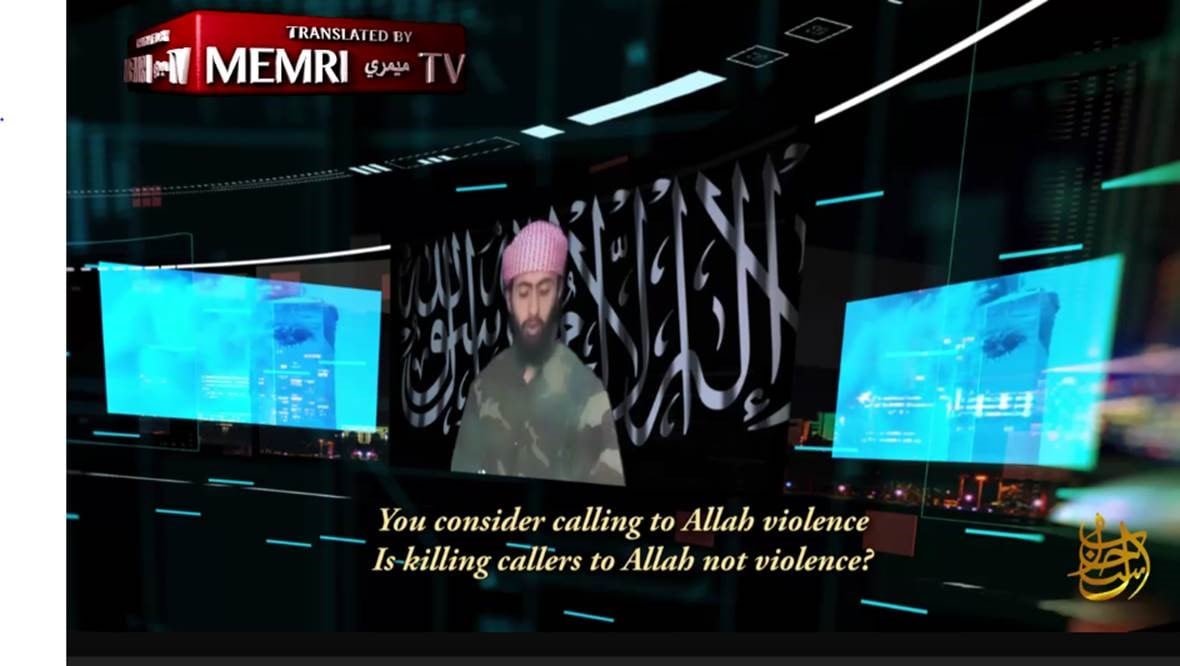On August 2, 2017, the Al-Sahab ("The Cloud") Foundation for Islamic Media Publication, Al-Qaeda's media arm, released a little-noticed audio recording featuring Al-Qaeda leader Ayman Al-Zawahiri commemorating the efforts of the organization's once-lauded media wing and honoring the "Al-Sahab martyrs." Al-Zawahiri dedicated a considerable part of his speech to praising Al-Sahab, those involved in it, and their families, for their commitment to serving the jihad and the mujahideen. He said: "Here, I must appreciate the blessed and immense services that Al-Sahab continues to render. The soldiers of this mujahid organization often pay a heavy price for the effort undertaken to make their message reach the Muslim audience, the price being none other than their own blood and the blood of their families, estrangement and alienation, pursuit by enemies, and persecution faced by their families."

After noting that Al-Sahab had been founded by Khaled Sheikh Muhammad, mastermind of the September 11 attacks, and describing him as "the towering icon of jihad," Al-Zawahiri asked Allah to bless "the martyrs of Al-Sahab," naming Zuhair Al-Maghribi, the German-Moroccan national who lived with 9/11 attackers Mohammed Atta and Ramzi bin Al-Shibh and had close connections with other 9/11 operatives in the Hamburg cell; Umar Al-Talib, a Saudi national previously on the Saudi most wanted terrorist list who narrated videos for Al-Sahab and was killed in a drone strike in July 2013; Ahmad Farooq, a dual U.S. citizen and deputy leader of Al-Qaeda in the Indian Subcontinent (AQIS) who was killed together with fellow American Adam Gadahn, who was also named. All of these men, Al-Zawahiri said, "exemplified patience and endurance, and sacrificed their lives to expose the deception of the contemporary Crusade."
The mission of Al-Sahab was to disseminate the organization's views and policies, promote global jihad, encourage young Muslims to identify with Al-Qaeda's jihad, and inspire homegrown terrorism. It was officially established in 2001, under Ayman Al-Zawahiri's son-in-law Abdul Rahman Al-Maghrebi and with the help of onetime Al-Qaeda leader Attiyah Allah Al-Libi, who headed the Al-Qaeda media committee that oversaw the organization's media outlets; they were later joined by Gadahn. At first, it distributed videos through trusted carriers and Arab TV networks, such as Al-Jazeera, or via local Pakistani TV stations; it later shifted to direct dissemination via jihadi forums and social media. Today it maintains a presence on Telegram and, until recently, on Twitter; its Twitter account was suspended in December 2016.

At its height, Al-Sahab Media produced all the exclusive statements of Al-Qaeda leaders Osama bin Laden and Ayman Al-Zawahiri, and had the power to both grab the attention of the Arab street and create fear in the Western media. Those involved in the war on terror in the period leading up to and following 9/11 can remember how, when a new Al-Sahab video aired, people would watch in suspense, paying attention to every word, examining any location or clue, and listening closely for any threat. Within a few years of Al-Sahab's creation, Gadahn, who was also starring in many of its videos and speaking in both English and fluent Arabic, was widely believed to be playing an important role in the organization. This is underlined by that fact that since his death in 2015, Al-Sahab has only released a few minor items, mainly audio recordings of Al-Zawahiri and Osama bin Laden's son Hamza – whom many speculate is being groomed to lead the organization – as well as the occasional online magazine and Al-Shabab General Command communique; these pale in comparison to ISIS's mass quantities of slickly produced media releases.
Even before Gadahn was killed, other jihadi groups, led by ISIS, overtook Al-Qaeda media efforts with their impressive use of social media platforms and encrypted technology. In an effort to stay relevant, Gadahn had begun pushing Al-Qaeda into social media. In an interview with Al-Qaeda's English-language online magazine Inspire in March 2013, he told readers that Al-Qaeda and its online sympathizers need to "make every effort to reach out to Muslims... through new media like Facebook and Twitter..."
Gadahn's death has significantly impacted and impeded Al-Qaeda's media efforts, bringing it nearly to a standstill. No one has taken up the effort, and his loss has had a devastating impact on the group's outreach, public relations, and more. On June 25, 2015, two months after his death was announced, AQIS published a special issue of its English-language online magazine Resurgence featuring a lengthy interview with him, in which he discussed the inner workings of Al-Sahab. In response to the question "[S]ome so-called experts and analysts in Western media and intelligence circles claim that you are the founder and/or head of Al-Sahab Foundation for Media Production. Does this claim have any substance?" Gadahn replied: "The fact is, I am neither the founder of Al-Sahab nor have I ever been its head. I didn't even start working with Al-Sahab until 2002, when we were in Karachi."
9/11 2017: Al-Sahab Promises Four Releases To Mark The 16th Anniversary Of 9/11 – But Only Republishes Two Old Releases
This year, on the evening of September 10, the Al-Sahab Telegram account published a full-color image of the Twin Towers along with a promise that it would be publishing four releases to mark the 16th anniversary of 9/11, creating considerable jihadi buzz online. However, on the day itself, it only released a single video and an old document that had been reported on years earlier.

The video, which was released first, featured the martyrdom will and testament of Muhannad Al-Shihri (aka Abu Omar Al-Azdi), one of the 9/11 hijackers aboard United Airlines Flight 175 which was flown into the South Tower of the World Trade Center. Al-Shihri's message is dated the 24th of Muharram, 1422, according to the Hijri calendar, which corresponds with April 18, 2001.

Al-Shihri concluded his video by stating: "O' Allah, You are our Supporter and Helper. With Your help we assault, with Your help we engage the enemy, with Your help we fight, and Allah is Sufficient for us and He is the best of trustees. America! Where shall you escape? The sea is behind you, we are in front of you, and there is no way out! If you accept Islam, you shall be safe and Allah will give you your reward and the reward of those after you, or else just wait for us. With the permission of Allah, we are coming for you to sever your heads, rip apart your bellies and make you fall over yourselves. You will be looking for rescue and there will be no way out. There will be no solution for you except death and then even more death. We have longed for your beautiful lands, for its streams and trees, palaces and lakes. We have resolved to tread upon your lands and embrace the maidens of Paradise on your soil. Your blood is delicious for us and your meat cheap. We are thirsty and nothing shall quench this thirst except your blood; nothing shall satiate our hunger except your meat. There is no stopping of what has been decreed by Allah. Given the fact that you invaded our lands, and we are men possessing loyalty and honor, we have resolved to visit you in your lands and gift you the most expensive of gifts worthy of your stature: coffins followed by coffins, bodies followed by bodies. Receive it until you are content with the gift, and it is a gift which will surely make you most glad..."
The second Al-Sahab release was a 20-page letter dated January 8, 2015, from Khalid Sheikh Muhammad (KSM) – referred to in the 9/11 Commission Report as "the principal architect of the 9/11 attacks" – to then-president Barack Obama. In this two-year-old letter, which had been released in February 2017 by The Miami Herald, KSM justifies the 9/11 attacks and says that the U.S. brought them on itself.

Note: On September 14, Al-Sahab published the third promised release – a lackluster audio recording by Hamza bin Laden dated 2017 calling on Muslims everywhere to support the jihad and the mujahideen in Syria.
Adam Gadahn Helped Al-Qaeda's Media Efforts Succeed – But After His Death, Its Media Is On Life Support
Gadahn used his knowledge of Western political and cultural language to hone Al-Qaeda's recruitment capabilities. As a 2008 Washington Post article explained, in terms of its online propaganda "Al-Qaeda's voice has grown much more powerful in recent years." The article added: "Taking advantage of new technology and mistakes by its adversaries, Al-Qaeda's core leadership has built an increasingly prolific propaganda operation, enabling it to communicate constantly, securely and in numerous languages with loyalists and potential recruits worldwide." After 9/11, media outlets often described Al-Qaeda's leadership's dependence on Gadahn for "advice on how to address a U.S. audience."
In the year that followed Gadahn's first appearance in an Al-Sahab video production, Al-Qaeda's media efforts expanded exponentially. Gadahn was the organization's perfect recruit. Not only was he a white American teenager, but he also was tech savvy and had media experience. From the outset, he represented a new breed of Al-Qaeda member, born in the West and raised in the Internet age.
His work helped Al-Qaeda brand itself, hone its message, and reach out more effectively to other young Americans and Westerners. In its first few years, Al-Sahab videos had a foreign feel to them; but by 2004 – once Gadahn had become the American face of Al-Qaeda – the organization could easily convey its message to the West, successfully reach a crucial American audience, and make Al-Qaeda more relatable to Westerners.
Gadahn's impact on Al-Qaeda became evident in speeches and videos by Osama bin Laden and Ayman Al-Zawahiri, as well as in other Al-Qaeda media productions, including English voiceover and other assistance in the production of the last will and testament martyrdom videos of some of the 9/11 terrorists and many similar Al-Qaeda videos. In his own Al-Sahab videos, Gadahn frequently cited leftist Western writers and films – true to his upbringing in a family that belonged to the far-left 1960s counterculture at the University of California, Irvine. These videos frequently featured Gadahn's quotes from and praise for the likes of Noam Chomsky, Robert Fisk, and George Galloway. He also often referenced activists and actors such as Michael Moore and Sean Penn, and former members of the U.S. military who opposed U.S. policy in the war on terror.
Now, on the 16th anniversary of 9/11, Al-Qaeda remains a major threat to the West with strong branches in the Middle East, North Africa, and Asia. Osama bin Laden and the 9/11 attacks continue to be revered by all jihadis. It can be assumed that senior members are continuing to plan major attacks – indeed, the only way Al-Qaeda can remain relevant is to carry out a large-scale attack that will energize its supporters. That is the point where the organization's young followers will surely pick up the mantle left behind by Gadahn to reinvigorate the all-but-forgotten Al-Sahab Foundation for Islamic Media Publication.
*Steven Stalinsky is executive director of The Middle East Media Research Institute (MEMRI), and author of the book American Traitor: The Rise and Fall of Al-Qaeda's U.S.-Born Leader Adam Gadahn, which is set for release this fall.




